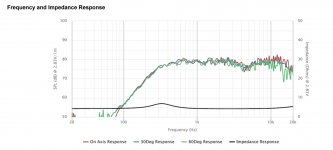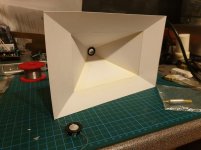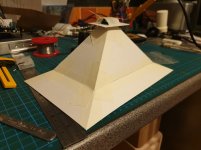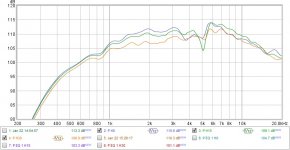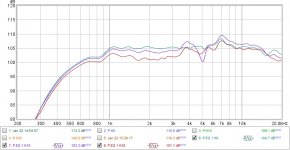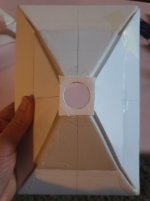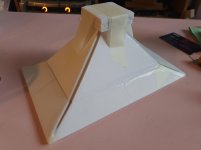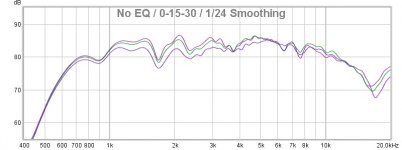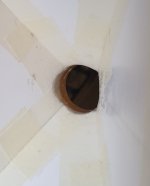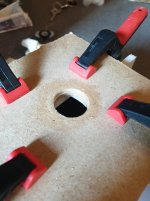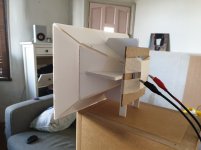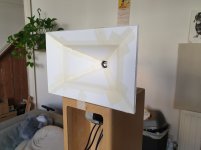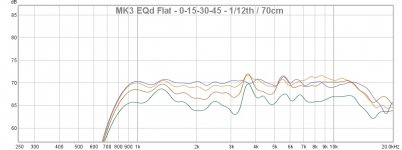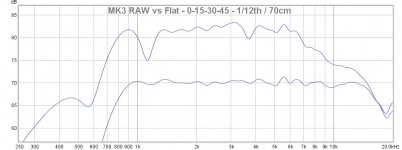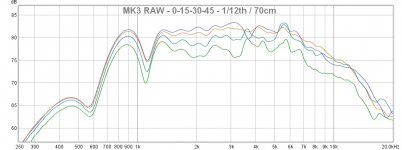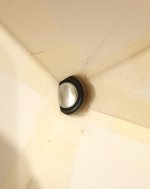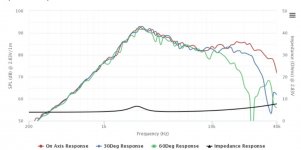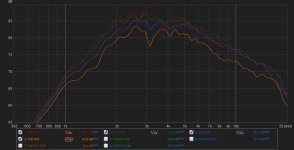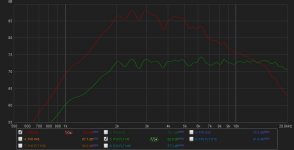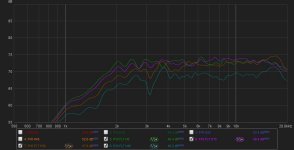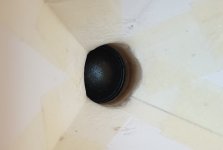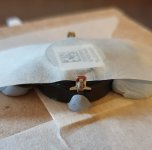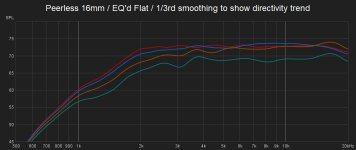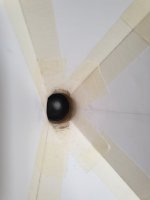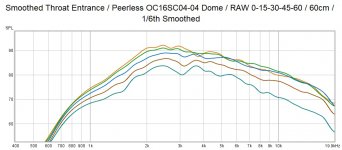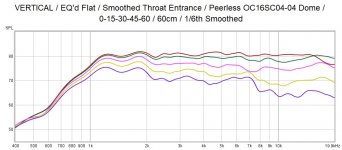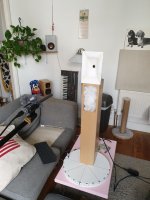Hi all,
Recently I got bitten by the horn bug and I wanted to make one. It is WAY harder than I thought but ultimately quite rewarding.
Trying to find an easy to construct design I landed upon the Bill Waslo SynergyCalc spread sheet which is super easy to use! (attached with my current settings) I thought a microspeaker would be cheap and fun to play with so I ordered two Peerless PMT-20N12AL04-04 drivers.
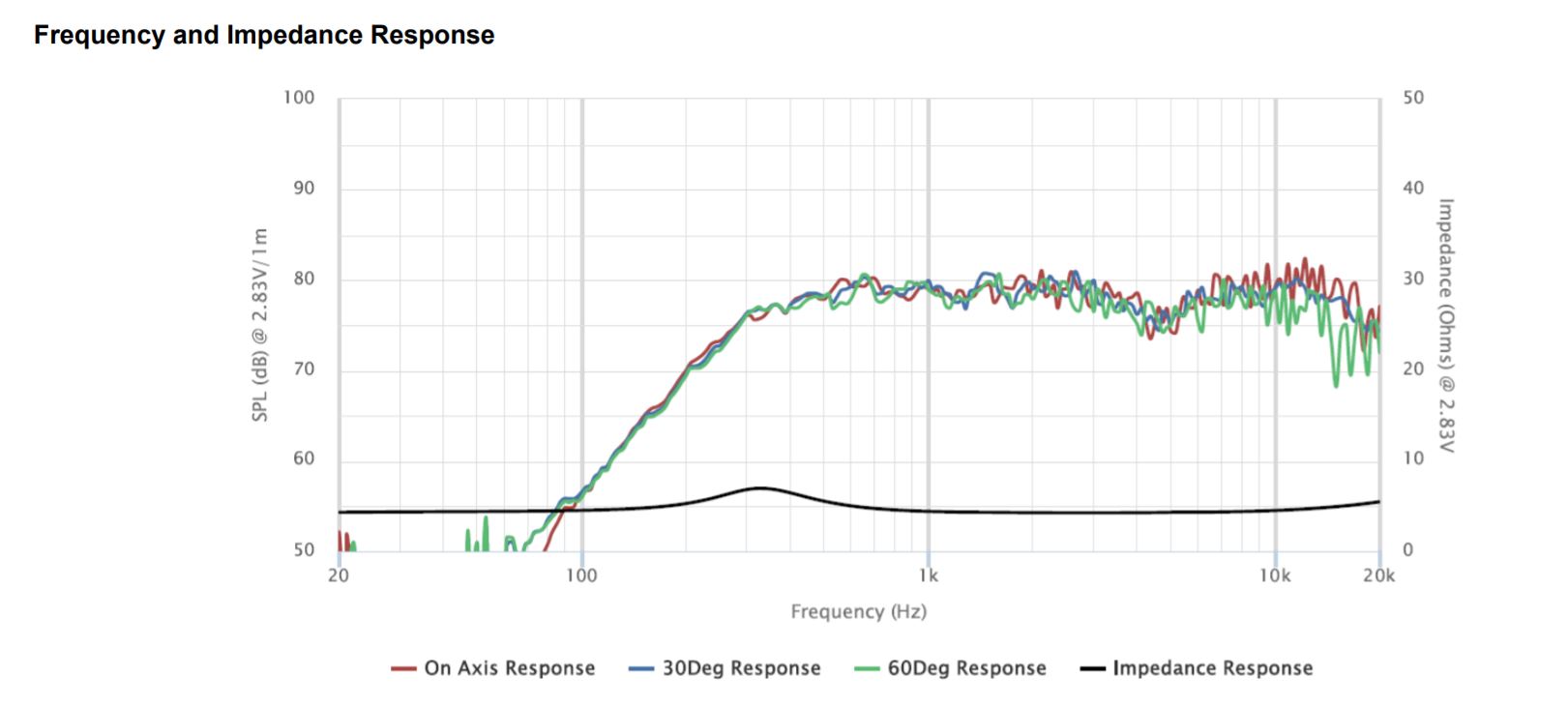
Here are my attempts so far and my observations on the failings (thanks to input from others):
MK1 Spec
- Made of 0.5mm card and masking tape
- A 1" throat to fit the diameter of the driver
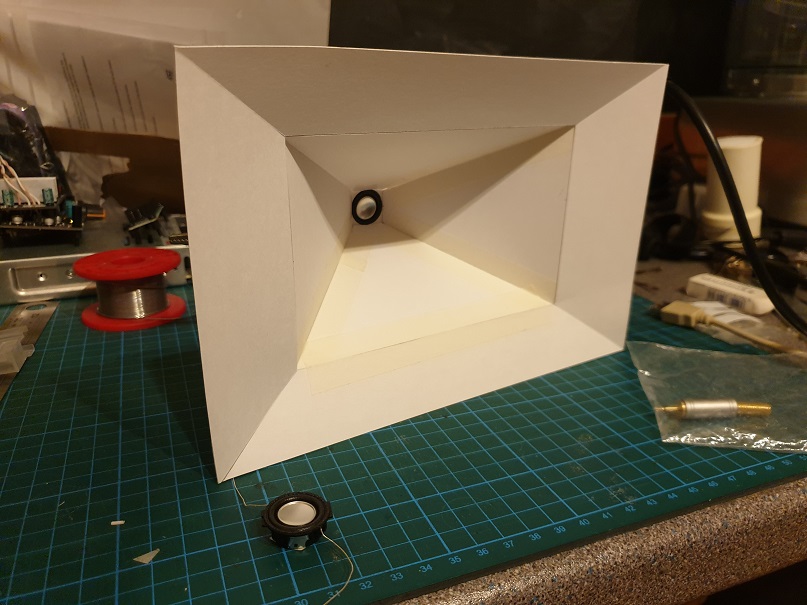
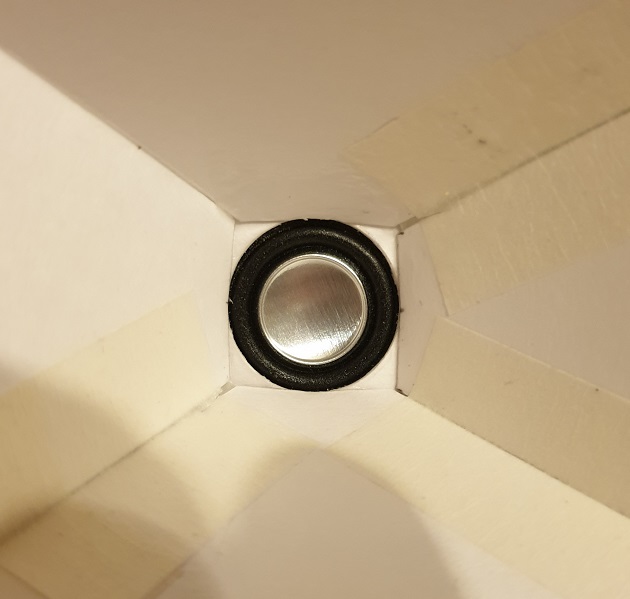
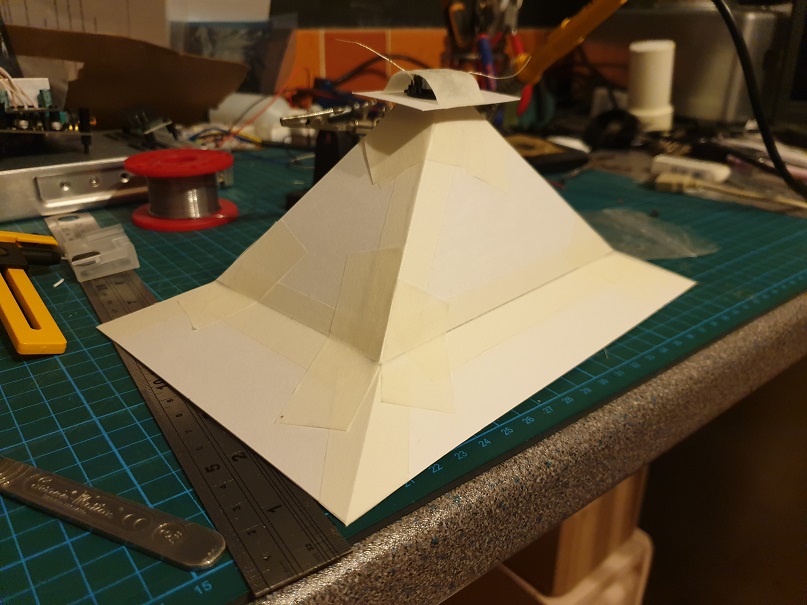
Raw response - Horizontal 0-15-30 degrees at about 70cm:
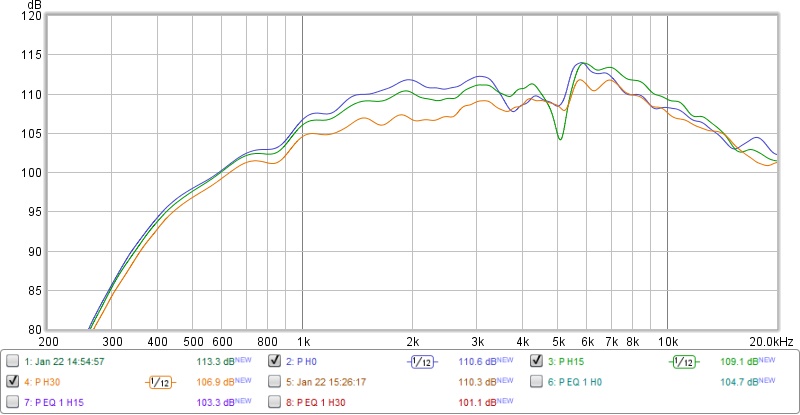
EQ'd Flat response - Horizontal 0-15-30 degrees at about 70cm:
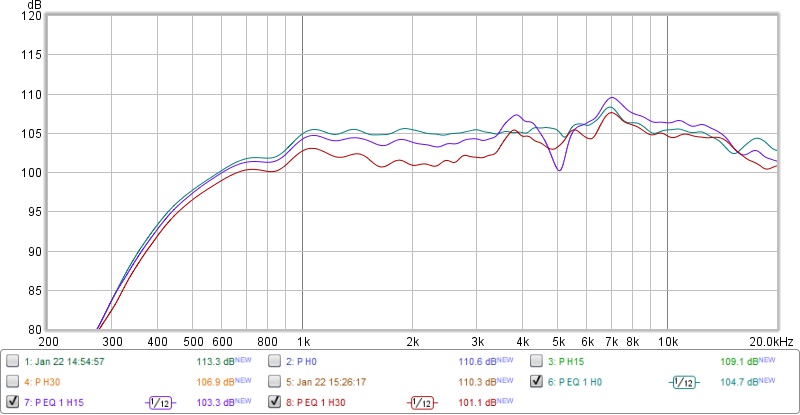
Observations on failings
- It's made of flippin' thin card
- Throat is too big for the surface area of the driver
- Response bunches up from 5k onwards
Recently I got bitten by the horn bug and I wanted to make one. It is WAY harder than I thought but ultimately quite rewarding.
Trying to find an easy to construct design I landed upon the Bill Waslo SynergyCalc spread sheet which is super easy to use! (attached with my current settings) I thought a microspeaker would be cheap and fun to play with so I ordered two Peerless PMT-20N12AL04-04 drivers.
Here are my attempts so far and my observations on the failings (thanks to input from others):
MK1 Spec
- Made of 0.5mm card and masking tape
- A 1" throat to fit the diameter of the driver
Raw response - Horizontal 0-15-30 degrees at about 70cm:
EQ'd Flat response - Horizontal 0-15-30 degrees at about 70cm:
Observations on failings
- It's made of flippin' thin card
- Throat is too big for the surface area of the driver
- Response bunches up from 5k onwards
Attachments
Last edited:
MK2 (aka I thought I was getting clever)
Spec:
- Made of 5mm foam board, masking tape a shed-load of glue
- (sort of) throat mounting plate
- Foam board cover for rear of driver which was stuffed
- Throat is correct for a 0.5" driver aperture
Raw response - Horizontal 0-15-30 degrees at about 70cm:
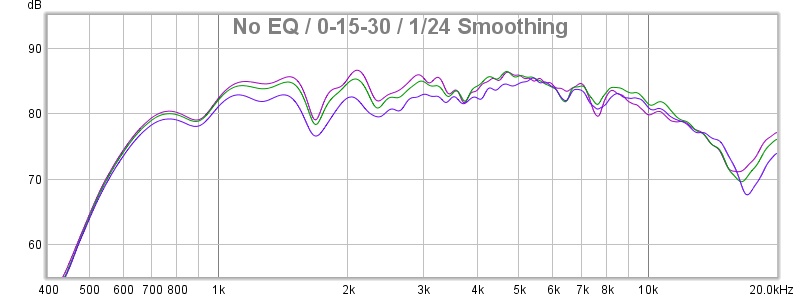
EQ'd Flat response - Horizontal 0-15-30 degrees at about 70cm:
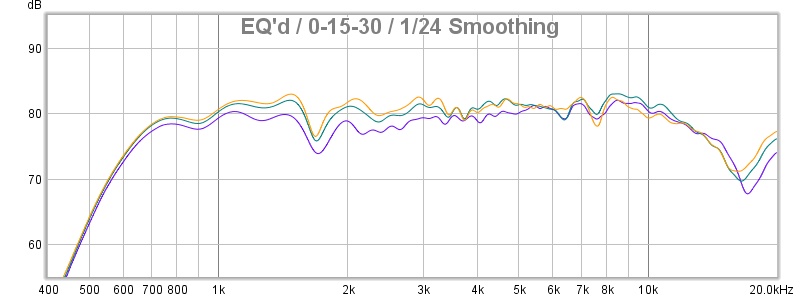
Observations on failings
- Weirdly a much choppier response yet nicer arc (although 1/24th smoothing)
- Still bunching up from 5k upwards
My theory on the more choppy response is that with the stiffer foam board I pushed resonances up in to the passband?
Patrick Bateman very kindly offered his advice on the bunching up:
"Your measurement shows this: above about 6khz, it doesn't see the walls at all, that's why the beamwidth is about 180degrees.
For your waveguide, the easiest fix would be to add a stub at the throat. Make it the same diameter as the driver. And then start with a length of about 25mm, and progressively shorten it.
The idea is that the 'stub' is going to take the converging wavefront and concentrate it into a flat wavefront. This is going to take some trial and error.
In horns and waveguides, the throat is paramount, you absolutely MUST get the throat right or the entire thing goes to hell. Geddes understands this, it's why he has a patent on interchangeable phase plugs. Basically you have to treat the driver, the phase plug and the waveguide as a single unit. A compression driver which works well on one waveguide may not work well on another."
Spec:
- Made of 5mm foam board, masking tape a shed-load of glue
- (sort of) throat mounting plate
- Foam board cover for rear of driver which was stuffed
- Throat is correct for a 0.5" driver aperture
Raw response - Horizontal 0-15-30 degrees at about 70cm:
EQ'd Flat response - Horizontal 0-15-30 degrees at about 70cm:
Observations on failings
- Weirdly a much choppier response yet nicer arc (although 1/24th smoothing)
- Still bunching up from 5k upwards
My theory on the more choppy response is that with the stiffer foam board I pushed resonances up in to the passband?
Patrick Bateman very kindly offered his advice on the bunching up:
"Your measurement shows this: above about 6khz, it doesn't see the walls at all, that's why the beamwidth is about 180degrees.
For your waveguide, the easiest fix would be to add a stub at the throat. Make it the same diameter as the driver. And then start with a length of about 25mm, and progressively shorten it.
The idea is that the 'stub' is going to take the converging wavefront and concentrate it into a flat wavefront. This is going to take some trial and error.
In horns and waveguides, the throat is paramount, you absolutely MUST get the throat right or the entire thing goes to hell. Geddes understands this, it's why he has a patent on interchangeable phase plugs. Basically you have to treat the driver, the phase plug and the waveguide as a single unit. A compression driver which works well on one waveguide may not work well on another."
Attachments
Last edited:
MK3 (aka let go of the ego and take some advice)
Specs:
- 5mm foam board with bracing and another shed load of PVA
- Integrated MDF throat 6mm stub and mounting plate
- LR4 high-pass at 800hz
Now we are getting some horn behaviour!
Raw response - Horizontal 0-15-30-45 degrees at about 70cm:
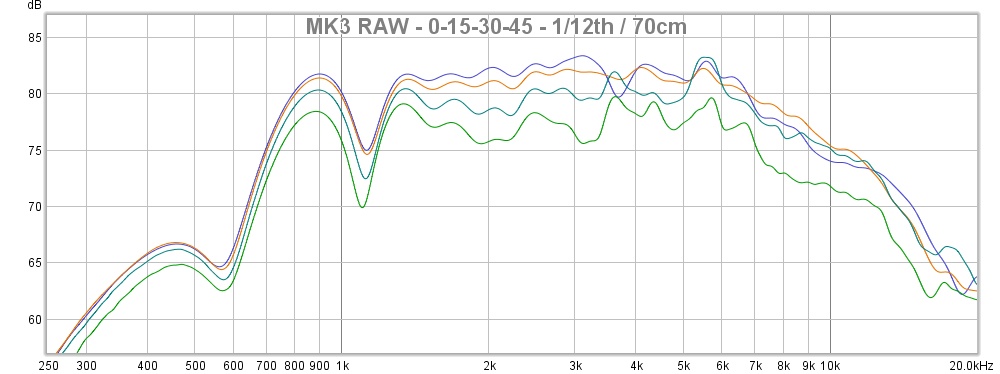
Raw vs EQ'd FLat

EQ'd flat response - Horizontal 0-15-30-45 degrees at about 70cm:
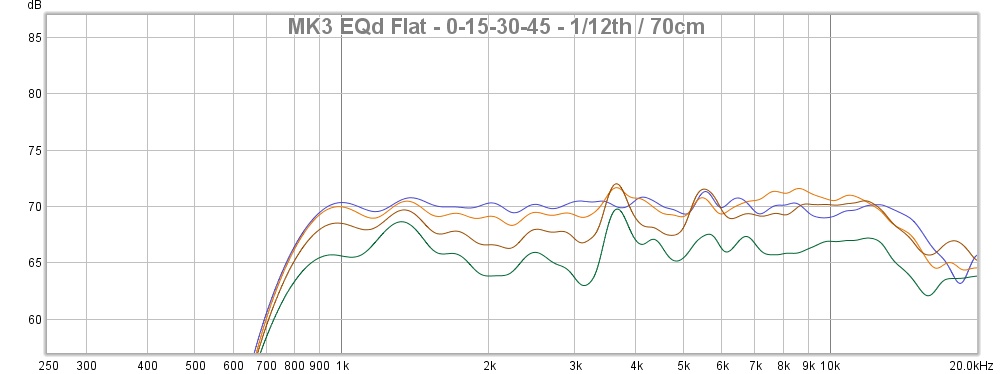
Observations on failings:
Something is still bunching up at 5.5k - perhaps some diffraction somewhere? Response seems to rise at 15 degrees and then recede in a horn like fashion at 30 degrees from this point.
Spike at 4.6k? Dip at 1.2k? Wtf bro?
Looking better, though and behaving like a CD horn, a bit.
Any feedback or advice on debugging this would be great 🙂
Specs:
- 5mm foam board with bracing and another shed load of PVA
- Integrated MDF throat 6mm stub and mounting plate
- LR4 high-pass at 800hz
Now we are getting some horn behaviour!
Raw response - Horizontal 0-15-30-45 degrees at about 70cm:
Raw vs EQ'd FLat
EQ'd flat response - Horizontal 0-15-30-45 degrees at about 70cm:
Observations on failings:
Something is still bunching up at 5.5k - perhaps some diffraction somewhere? Response seems to rise at 15 degrees and then recede in a horn like fashion at 30 degrees from this point.
Spike at 4.6k? Dip at 1.2k? Wtf bro?
Looking better, though and behaving like a CD horn, a bit.
Any feedback or advice on debugging this would be great 🙂
Attachments
Last edited:
OK, so now I have all these prototypes together I can see one clear common element of behaviour.
It all goes to poop after 3.6k. Someone on FB suggested that the driver was going in to break-up, perhaps at this point?
It all goes to poop after 3.6k. Someone on FB suggested that the driver was going in to break-up, perhaps at this point?
Nice work! I have made several foam core synergy horns and the thing you have to do is use some modeling clay/putty and round out all the sharp edges and corners within 2in of the horn throat. You also need to make sure there is a smooth transition from the driver surround to the throat. This can be made of bondo and allowed to harden or 3D print the throat adapter. This one detail was the focus of about 2 weeks of work between myself and Bushmeister in the bookshelf point source horn project. We finally solved it for the SB65WBAC25-4 driver. But took many iterations. This is what causes the dip that you have.
https://www.diyaudio.com/forums/ful...ndy-fast-waw-applications-10.html#post4033969
Presenting the Trynergy - a full range tractrix synergy.
Thirst adapter:
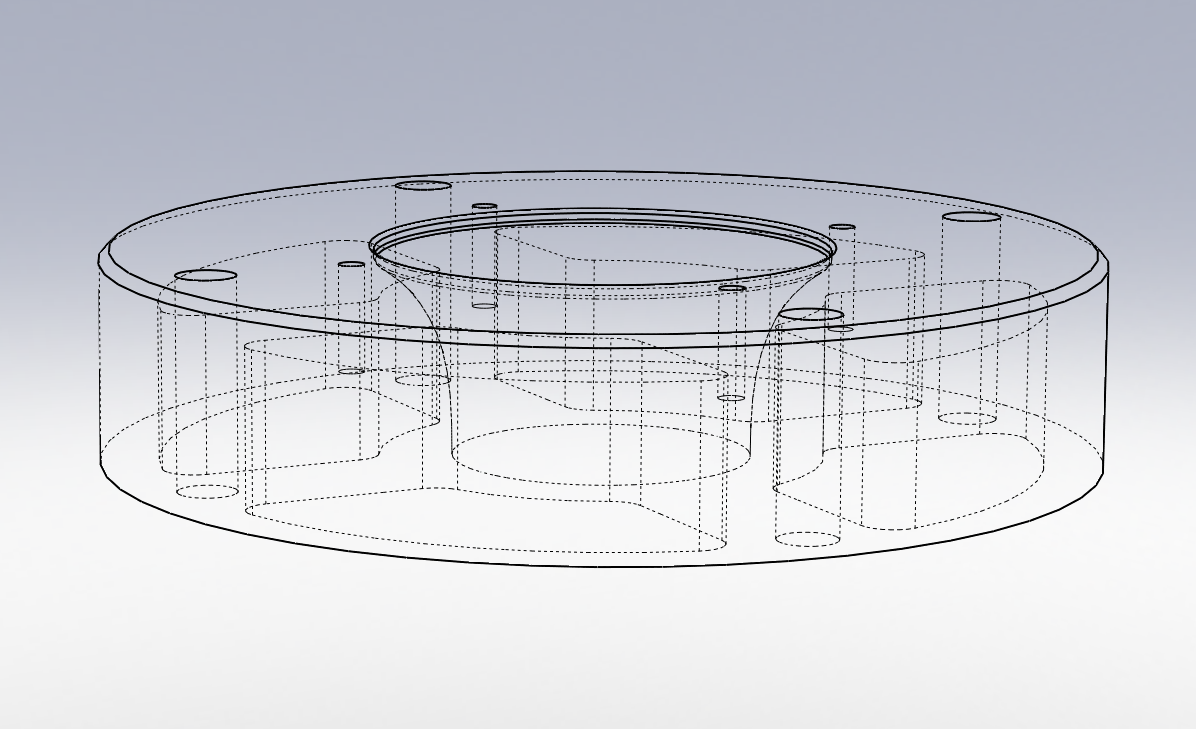
A Bookshelf Multi-Way Point-Source Horn
On the Trynergy here were the dips I got due to those tweeter edge effects:
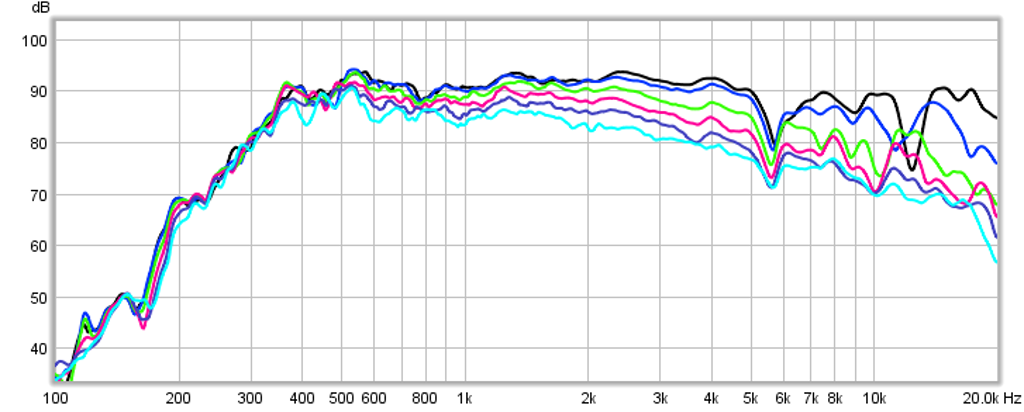
Here was my AMT synergy:
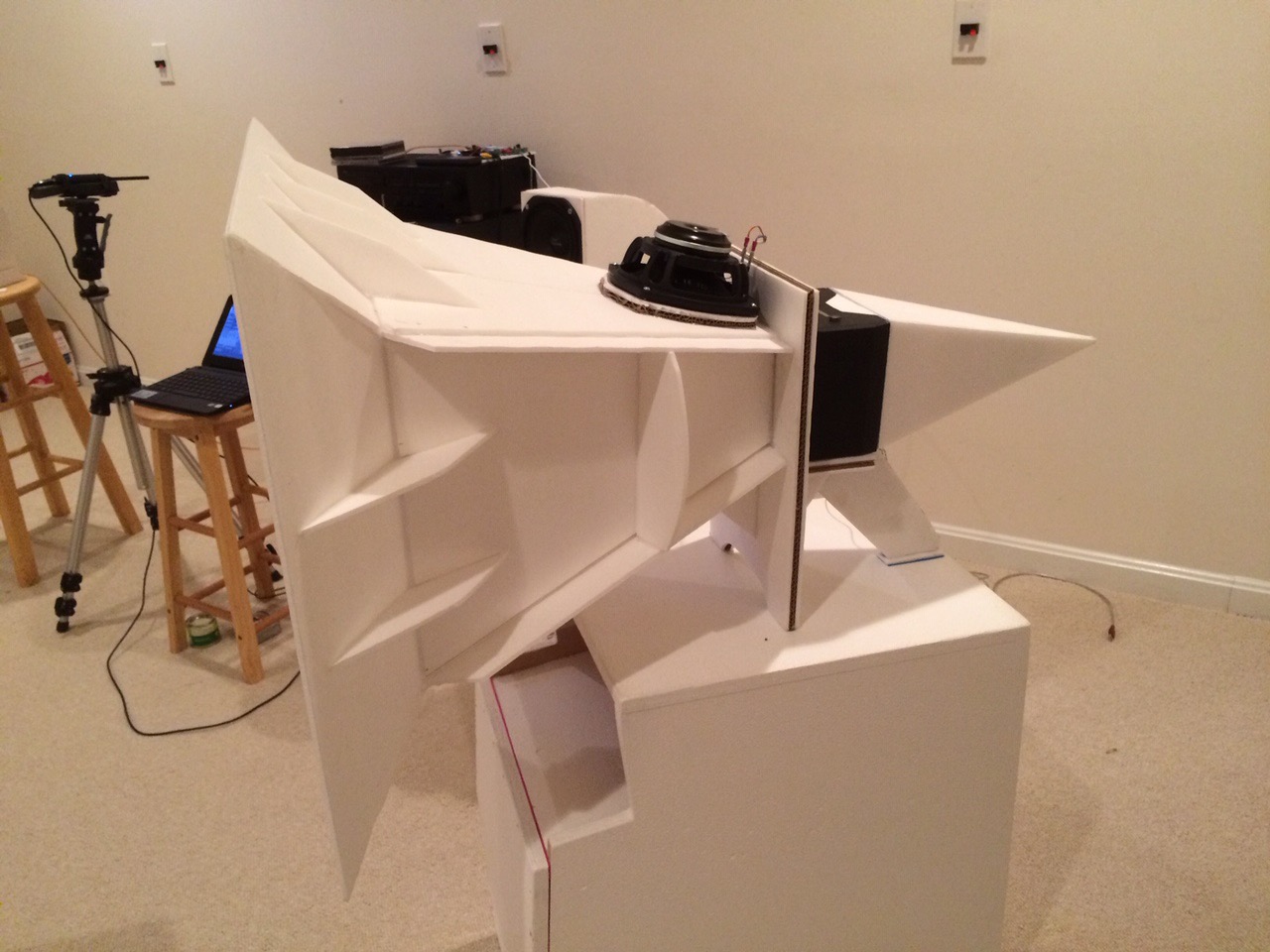
https://www.diyaudio.com/forums/ful...ndy-fast-waw-applications-10.html#post4033969
Presenting the Trynergy - a full range tractrix synergy.
Thirst adapter:

A Bookshelf Multi-Way Point-Source Horn
On the Trynergy here were the dips I got due to those tweeter edge effects:

Here was my AMT synergy:
Last edited:
Cool project grahamgraham...grass roots learning type...the kind of project i really enjoy too
thx for sharing
u too xrk971 !
thx for sharing
u too xrk971 !
Nice work! I have made several foam core synergy horns and the thing you have to do is use some modeling clay/putty and round out all the sharp edges and corners within 2in of the horn throat. You also need to make sure there is a smooth transition from the driver surround to the throat. This can be made of bondo and allowed to harden or 3D print the throat adapter. This one detail was the focus of about 2 weeks of work between myself and Bushmeister in the bookshelf point source horn project. We finally solved it for the SB65WBAC25-4 driver. But took many iterations. This is what causes the dip that you have.
Cheers man, thanks for the feedback! Would you mind clarifying a couple of things, please? Which dip are you referring to?
Also, I have attached a higher-res image of the throat and driver. Can you expand on your suggestion with regards to the picture, please?
Lots of reading to do on your threads 🙂
Attachments
Last edited:
Cool project grahamgraham...grass roots learning type...the kind of project i really enjoy too
thx for sharing
u too xrk971 !
Yeah! I wanted to try and understand from hands-on learning. I have two horns I am going to use in another project but want to understand, as you say, from a grass roots level!
My other current thread is a system based around a JBL H9800 Horn 🙂
Referee blows whistle...!
Good DIY project Sir, but to be a Unity or Synergy you must also have midrange(s) and port(s). Please butcher your prototype accordingly and re-submit. To be fair, it occurs to me that you were not claiming to make a Multiple Entry horn, but the use of the software product indicates implied endorsement of the concept 🙄
Defense, ten yard penalty 😀
Good DIY project Sir, but to be a Unity or Synergy you must also have midrange(s) and port(s). Please butcher your prototype accordingly and re-submit. To be fair, it occurs to me that you were not claiming to make a Multiple Entry horn, but the use of the software product indicates implied endorsement of the concept 🙄
Defense, ten yard penalty 😀
Last edited:
Good DIY project Sir, but to be a Unity or Synergy you must also have midrange(s) and port(s).
Defense, ten yard penalty 😀
I didnt say it was either! 🙂
I meant the dip at 3.7kHz. That would correspond to a 4.6cm half wave cancellation. That might be the distance from the back of the cone to the rear chamber?
MK3.1 (aka horn sanity check)
It isn't that I didn't believe any of the suggestions or explanations given regarding the lack of directivity from 3.6khz upwards, I just wanted to something out - the micro driver.
To do this I got hold of a Peerless OC16SC04-04 16mm dome tweeter for the princely sum of £4.30 from CPC. It took them 2 attempts to get one to me without the dome being pushed in but that's another story.
I picked this driver because of it's small diaphragm size that would hopefully give me a smooth HOM (?) free response in the upper octaves. It's FS of 2150hz is too high for use below that and it's response drops off a cliff anyway. I just wanted to check dispersion and diffraction was due to the horn and nothing else.
Here is the factory FR:
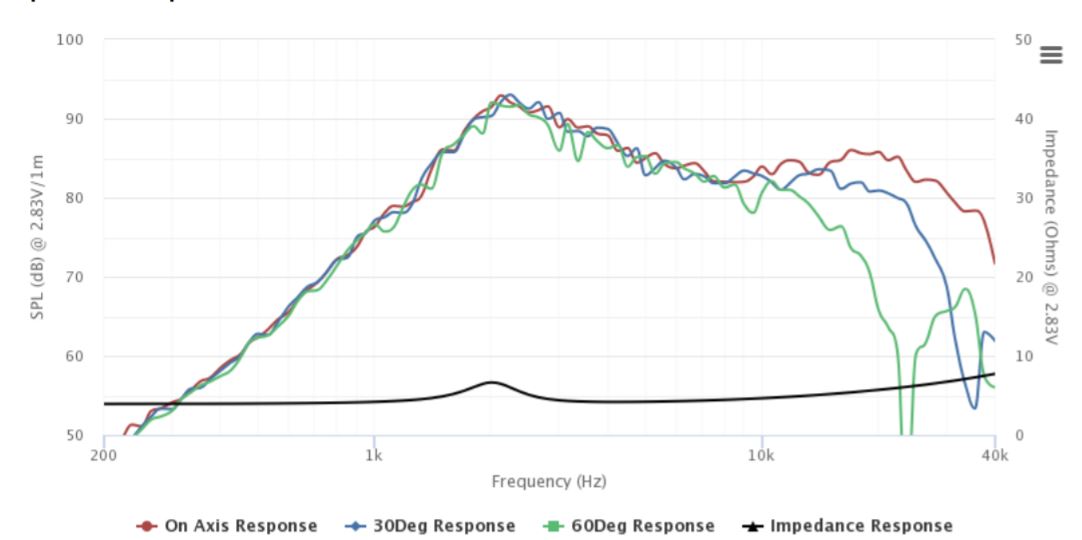
I used a 1mm shim to stand the driver off from the throat mounting plate as the dome surround would get squashed as it was a mm too wide for the throat:
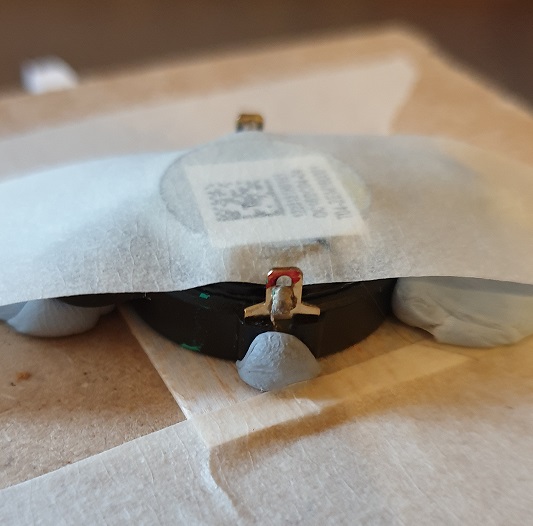
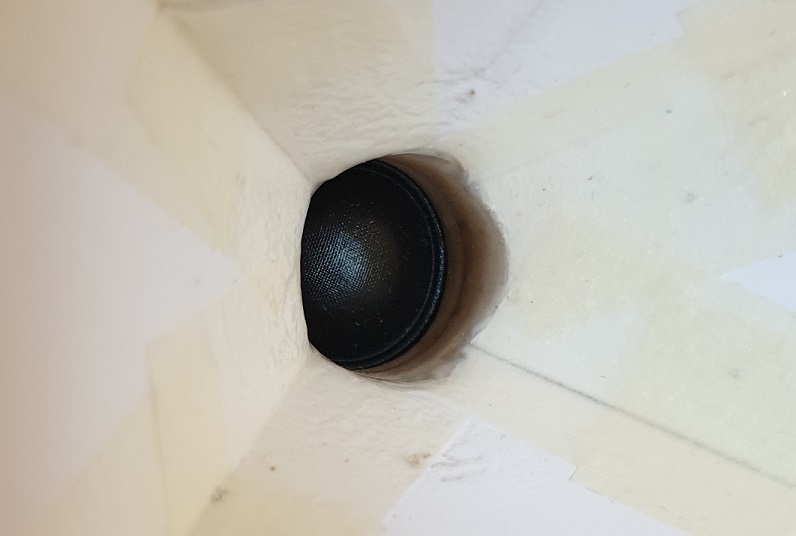
Raw 0-15-30-45:
(I switched to dark so that the curves could be seen better as they are bunched up)
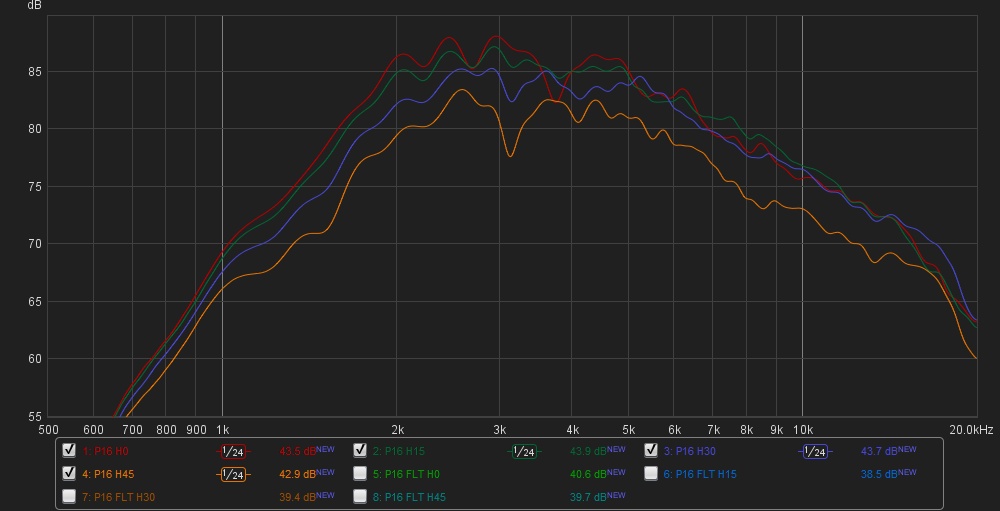
Raw vs EQ'd flat:
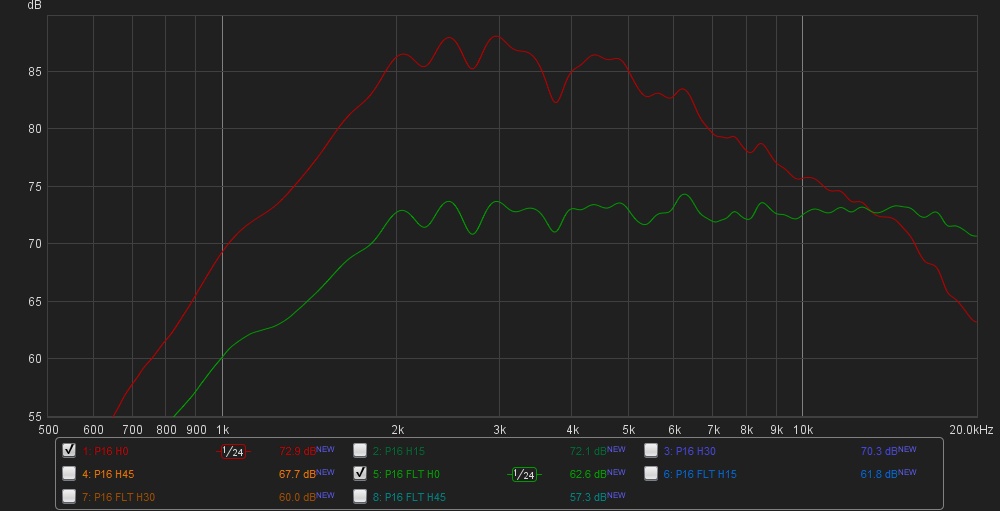
EQ'd Flat 0-15-30-45:

What did this prove to me that hasn't already been suggested? Well, it isn't the micro driver in break up from 3.6khz, that's all (oh and loosely supplied tweeters shouldn't be posted in a padded envelope, duh)
What is apparent is that the response goes up from 0-15-30 then starts behaving like a CD horn at 45 degrees.
I need to continuing extending the throat entrance and I was also thinking about trying some foam here and there.
It isn't that I didn't believe any of the suggestions or explanations given regarding the lack of directivity from 3.6khz upwards, I just wanted to something out - the micro driver.
To do this I got hold of a Peerless OC16SC04-04 16mm dome tweeter for the princely sum of £4.30 from CPC. It took them 2 attempts to get one to me without the dome being pushed in but that's another story.
I picked this driver because of it's small diaphragm size that would hopefully give me a smooth HOM (?) free response in the upper octaves. It's FS of 2150hz is too high for use below that and it's response drops off a cliff anyway. I just wanted to check dispersion and diffraction was due to the horn and nothing else.
Here is the factory FR:
I used a 1mm shim to stand the driver off from the throat mounting plate as the dome surround would get squashed as it was a mm too wide for the throat:
Raw 0-15-30-45:
(I switched to dark so that the curves could be seen better as they are bunched up)
Raw vs EQ'd flat:
EQ'd Flat 0-15-30-45:
What did this prove to me that hasn't already been suggested? Well, it isn't the micro driver in break up from 3.6khz, that's all (oh and loosely supplied tweeters shouldn't be posted in a padded envelope, duh)
What is apparent is that the response goes up from 0-15-30 then starts behaving like a CD horn at 45 degrees.
I need to continuing extending the throat entrance and I was also thinking about trying some foam here and there.
Attachments
Last edited:
I need to figure out how to model this in Hornresp, I really wanted to do this the hard way but learning how to sim something other than TLs and MLTLs would be a good move.
MK3.3 (aka Topsy Turvy World)
Right, so I smoothed the throat entry although it doesn't look all that different. It's hard to show with white foam board with layers of PVA layered and filed over.
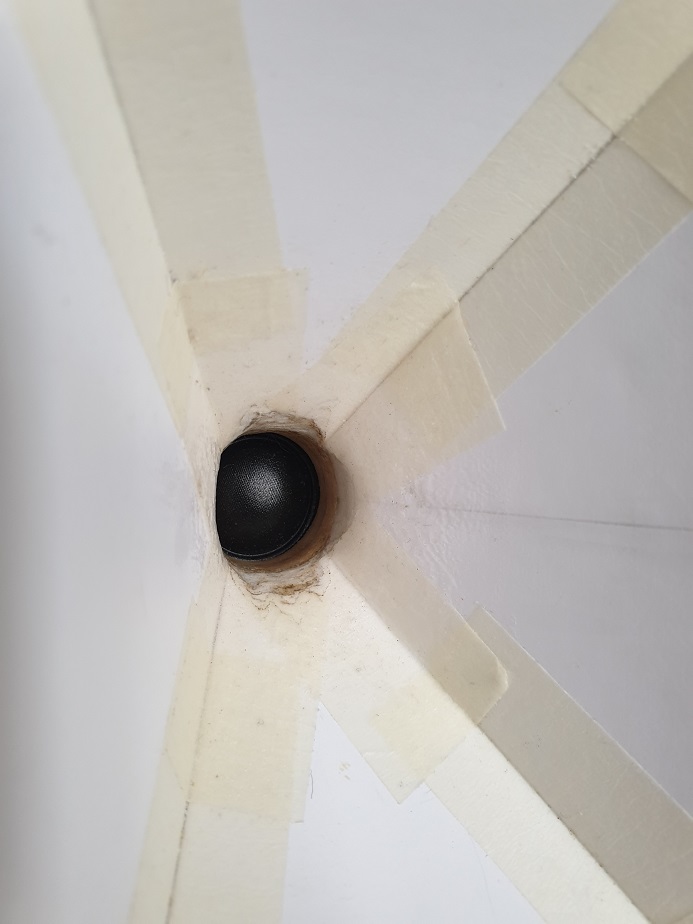
Which resulted in this:
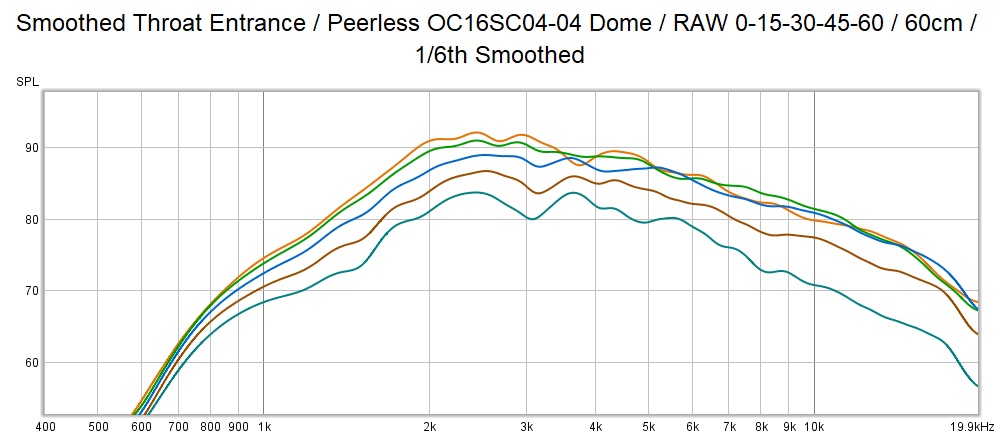
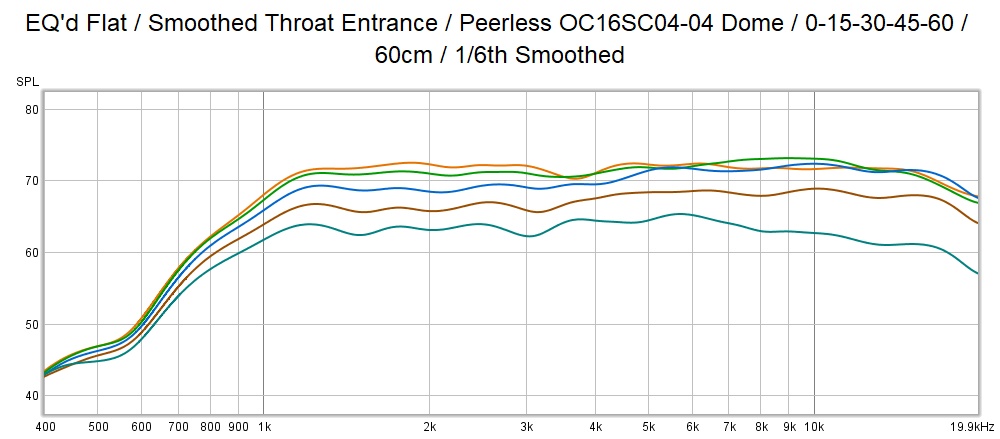
Slightly better response overall but still NO DICE on the directivity control (or lack thereof).
NOW, I should have thought about this sooner but the pattern that is seen is incredibly similar to another project I am working on with a pair of JBL H9800 molded horn clones. As Earl points out here: System Based Around JBL H9800 Horn the H9800 is a diffraction horn and that is why it keeps the response wide from 3k upwards.
So, as Earl suggested (and, from memory, as Greg Timbers recommends) I rotated the H9800 and got a great linear separation to my polar responses. SO I did the same with this horn:
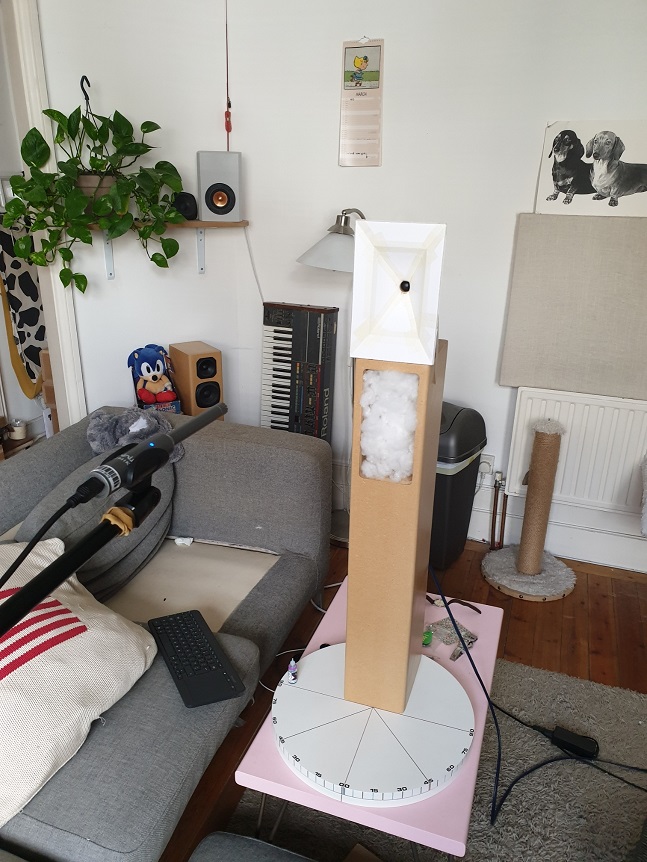
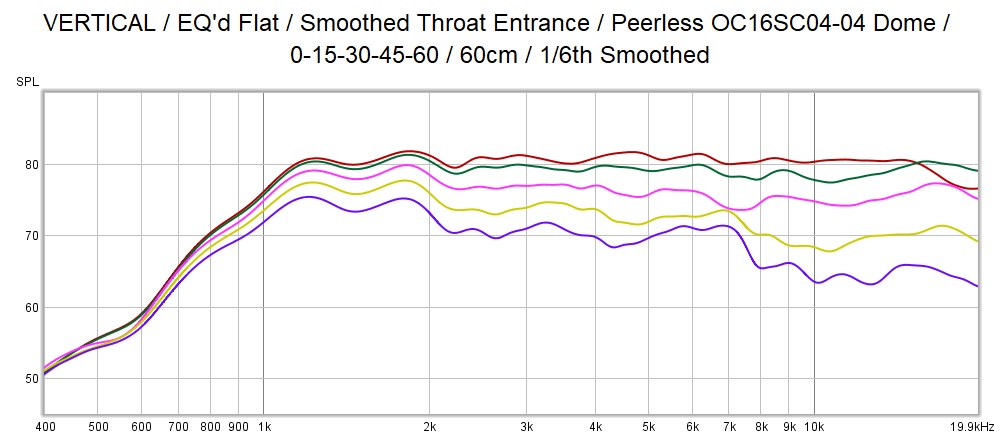
Well smack my bum and call me Mr. Timbers, that looks like what I have been after!
So, now to reverse engineer it. From knowing that the H9800 has diffraction slots on the top and bottom of the start horn near the throat (when oriented horizontally) this points to their being a diffraction issue with this horn. But, what is it?
It must have something to do with first top and bottom sections. Perhaps their length (8cm) and then diffraction from the abrupt change in angle to the second section? Or simply reflections between the two angles? Or maybe I need to work on my top and bottom throat entry more to make it smoother?
The spreadsheet was set to 90x60 degrees coverage. Please, have a look at it if you fancy, it is on my first post with my settings default.
Right, so I smoothed the throat entry although it doesn't look all that different. It's hard to show with white foam board with layers of PVA layered and filed over.
Which resulted in this:
Slightly better response overall but still NO DICE on the directivity control (or lack thereof).
NOW, I should have thought about this sooner but the pattern that is seen is incredibly similar to another project I am working on with a pair of JBL H9800 molded horn clones. As Earl points out here: System Based Around JBL H9800 Horn the H9800 is a diffraction horn and that is why it keeps the response wide from 3k upwards.
So, as Earl suggested (and, from memory, as Greg Timbers recommends) I rotated the H9800 and got a great linear separation to my polar responses. SO I did the same with this horn:
Well smack my bum and call me Mr. Timbers, that looks like what I have been after!
So, now to reverse engineer it. From knowing that the H9800 has diffraction slots on the top and bottom of the start horn near the throat (when oriented horizontally) this points to their being a diffraction issue with this horn. But, what is it?
It must have something to do with first top and bottom sections. Perhaps their length (8cm) and then diffraction from the abrupt change in angle to the second section? Or simply reflections between the two angles? Or maybe I need to work on my top and bottom throat entry more to make it smoother?
The spreadsheet was set to 90x60 degrees coverage. Please, have a look at it if you fancy, it is on my first post with my settings default.
Attachments
Last edited:
Just a little addendum:
I'm not criticising Bills spread sheet or horn design, I want that to be clear! I am just using his sheet and adapting it for my needs as I am a total beginner at horn design and needed a leg up.
His designs are noted to be very special indeed and one day when I have the tools and space I'd like to try some of them on a scale befitting of them!
I'm not criticising Bills spread sheet or horn design, I want that to be clear! I am just using his sheet and adapting it for my needs as I am a total beginner at horn design and needed a leg up.
His designs are noted to be very special indeed and one day when I have the tools and space I'd like to try some of them on a scale befitting of them!
- Home
- Loudspeakers
- Multi-Way
- 1000hz Foam Board Conical Horn (SynergyCalc)
